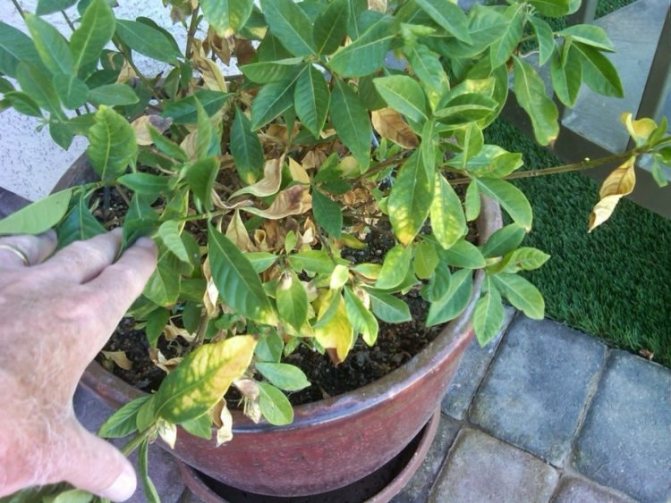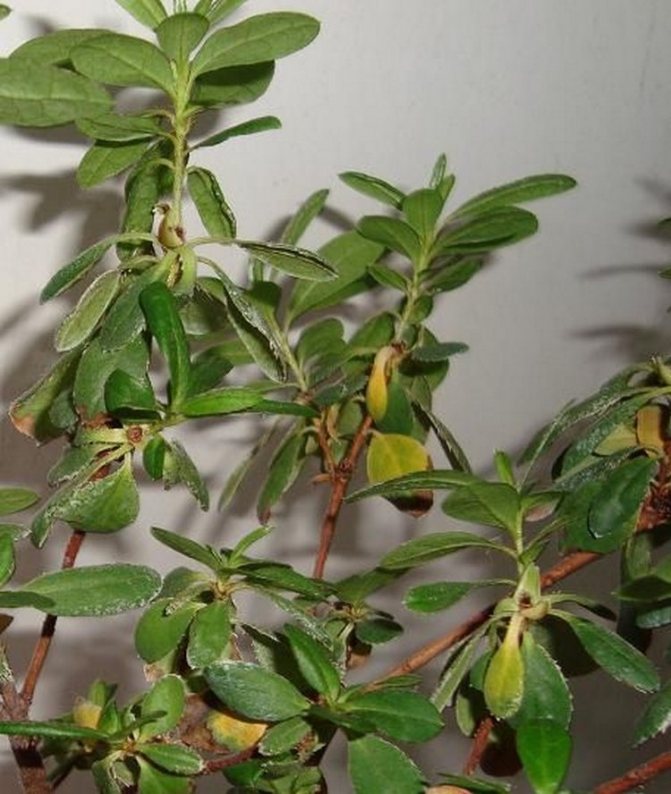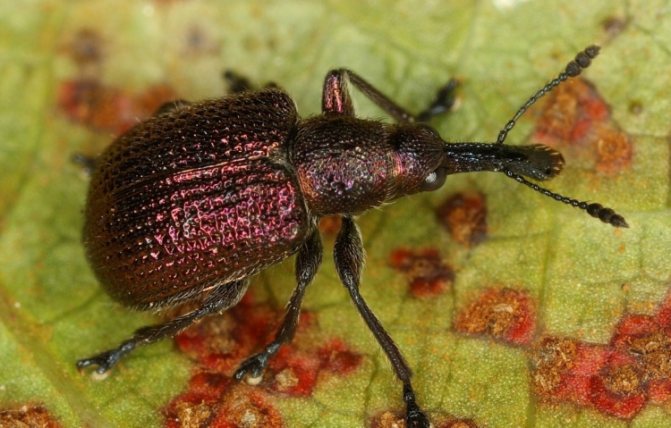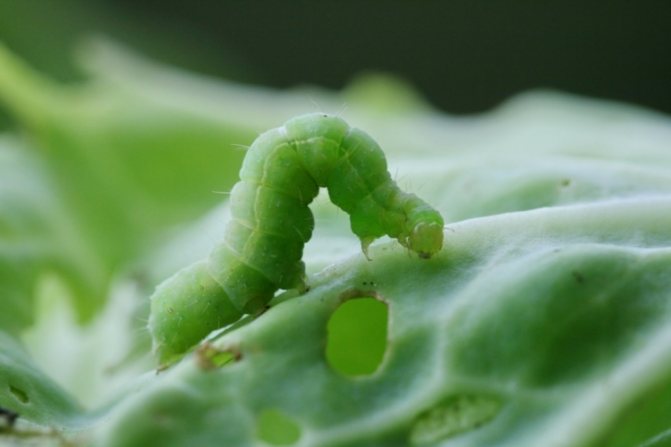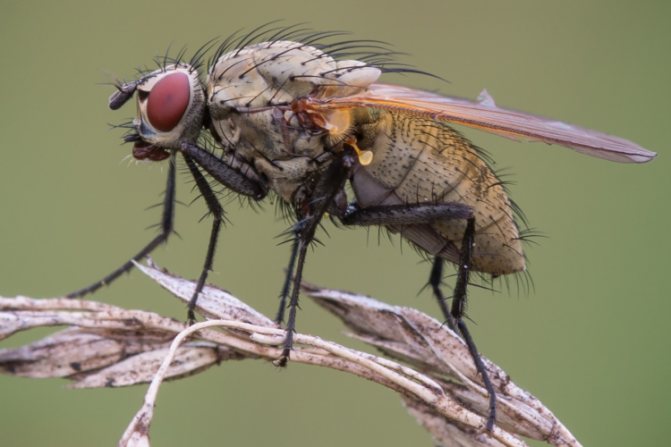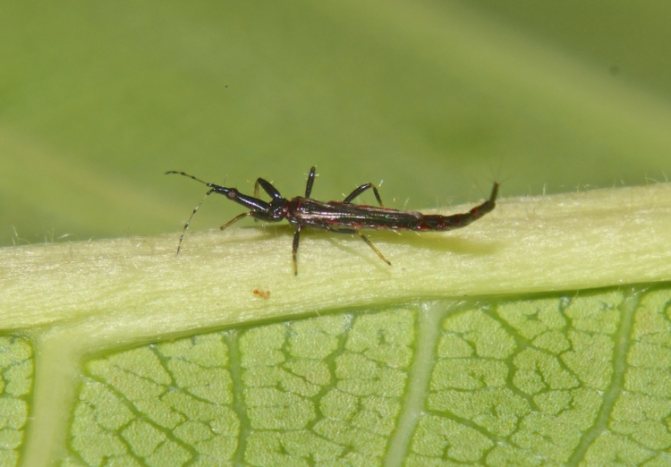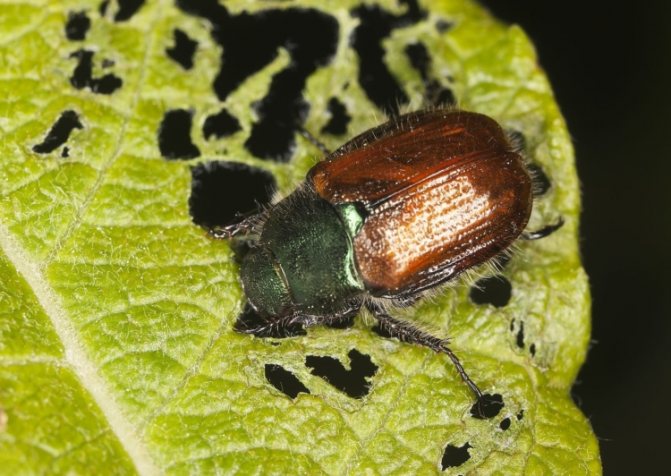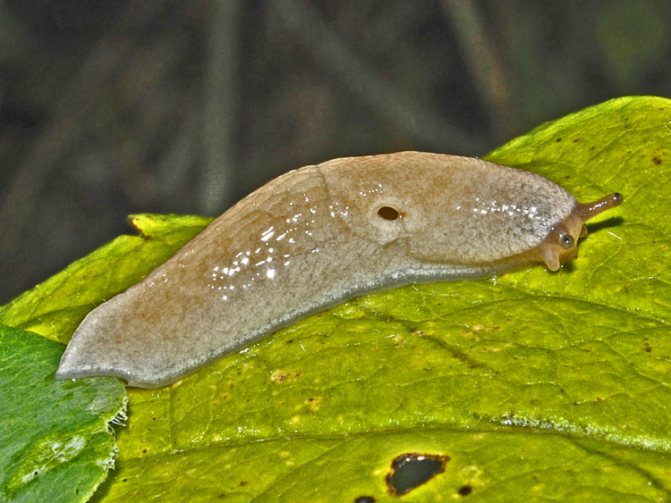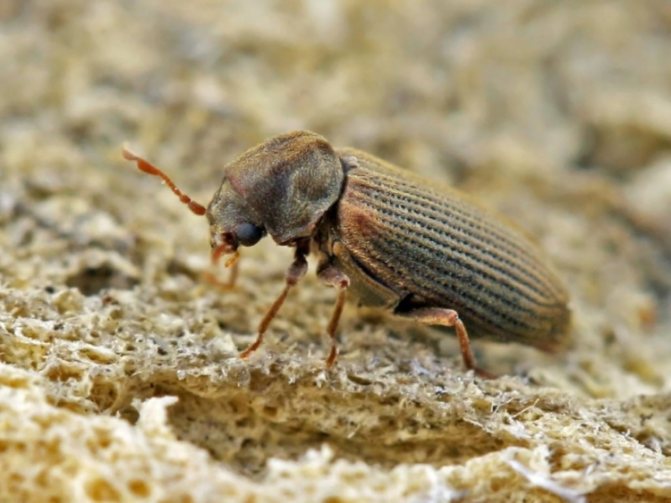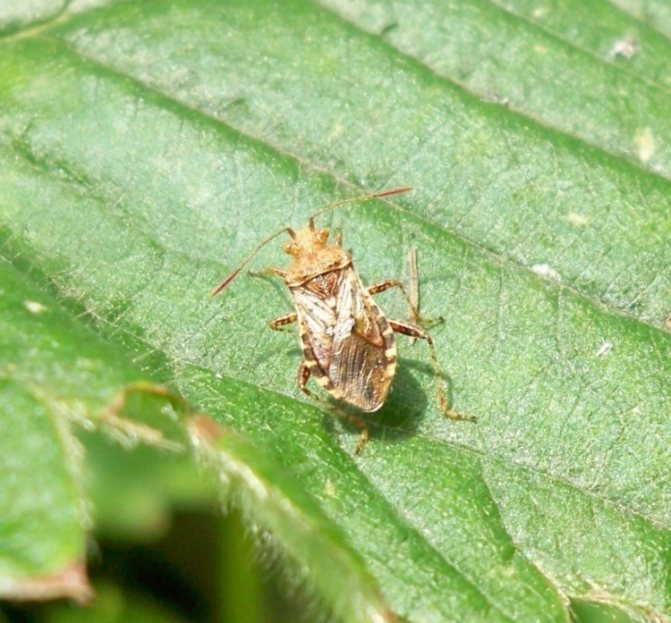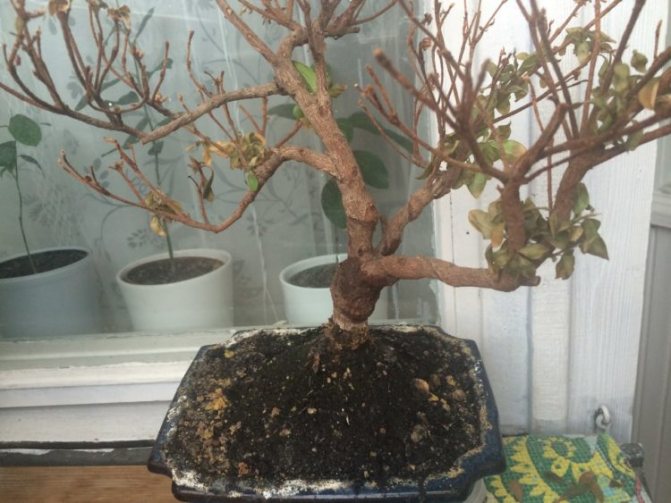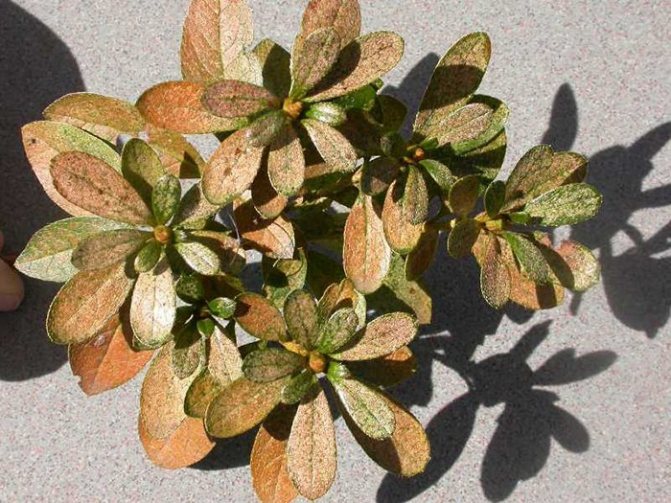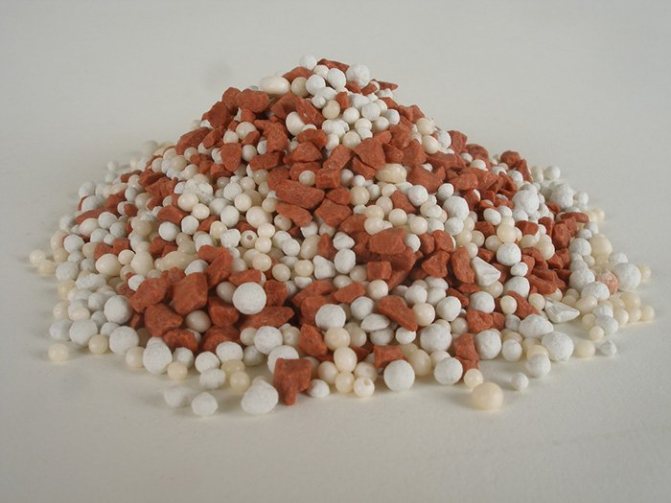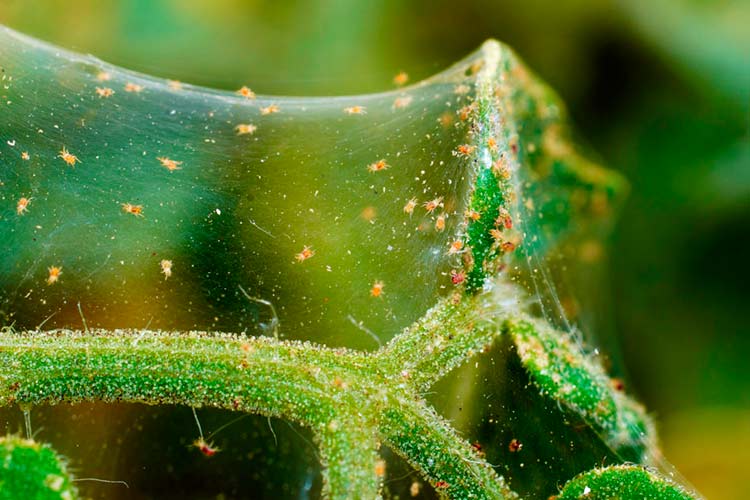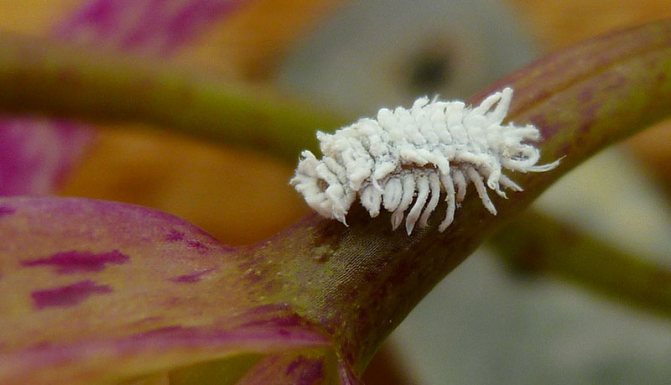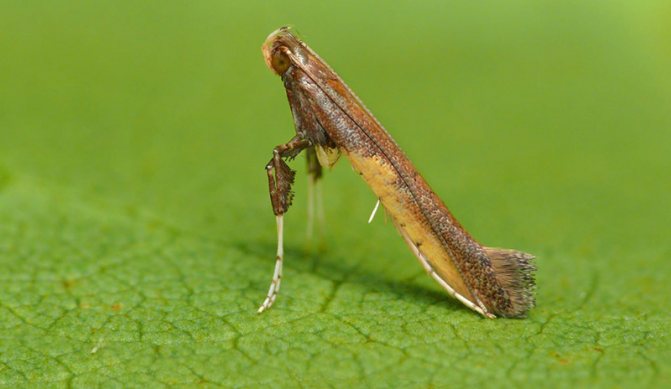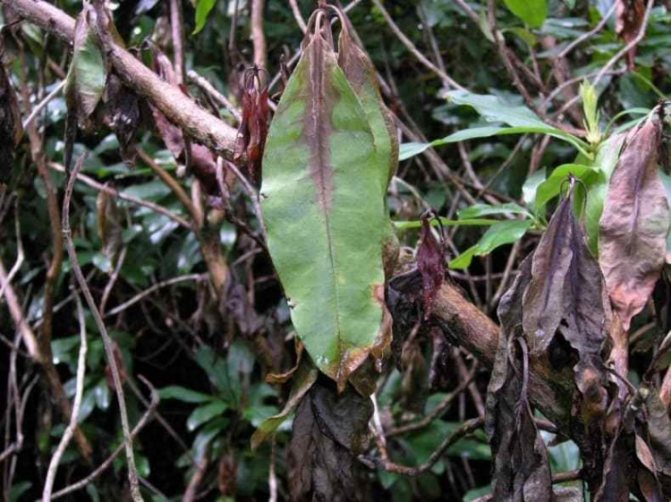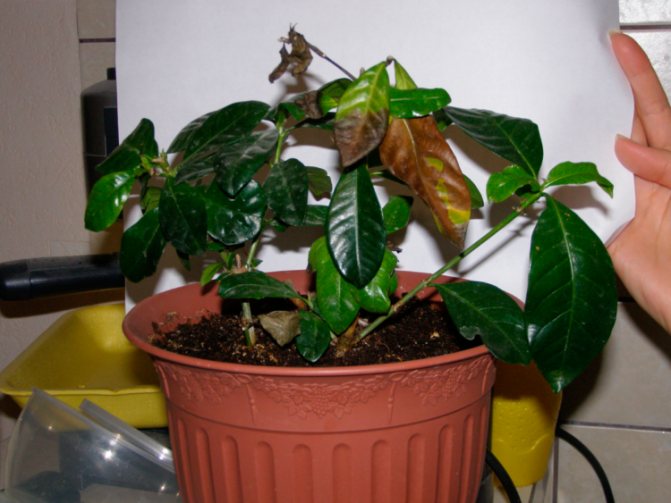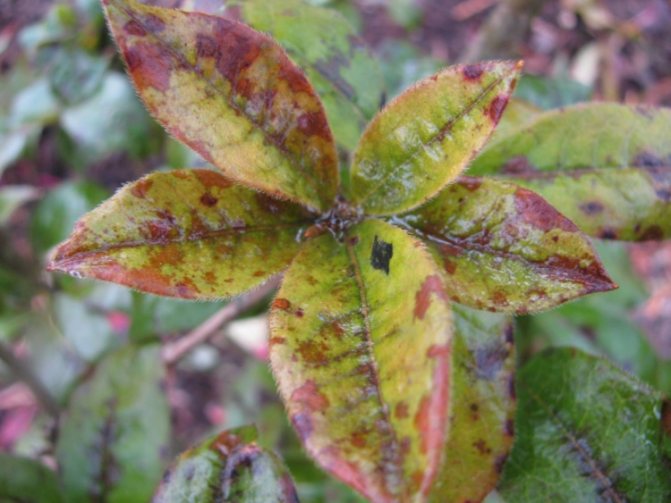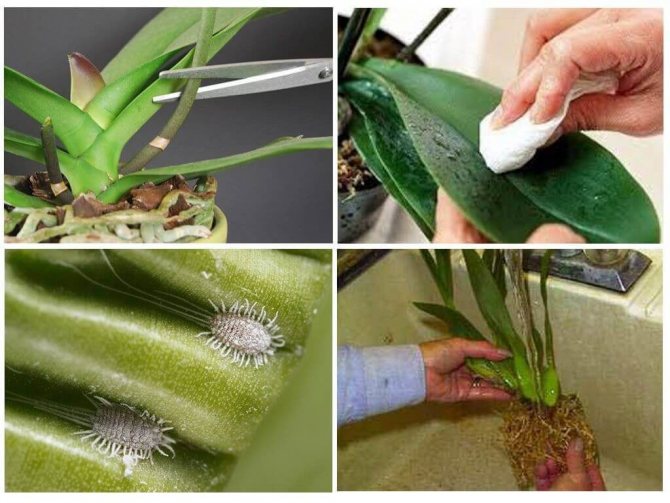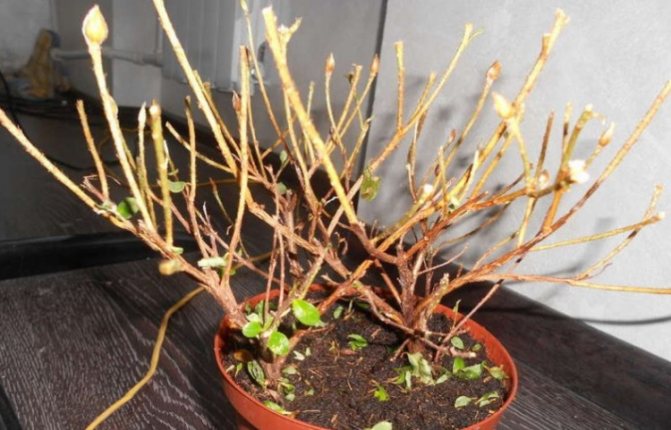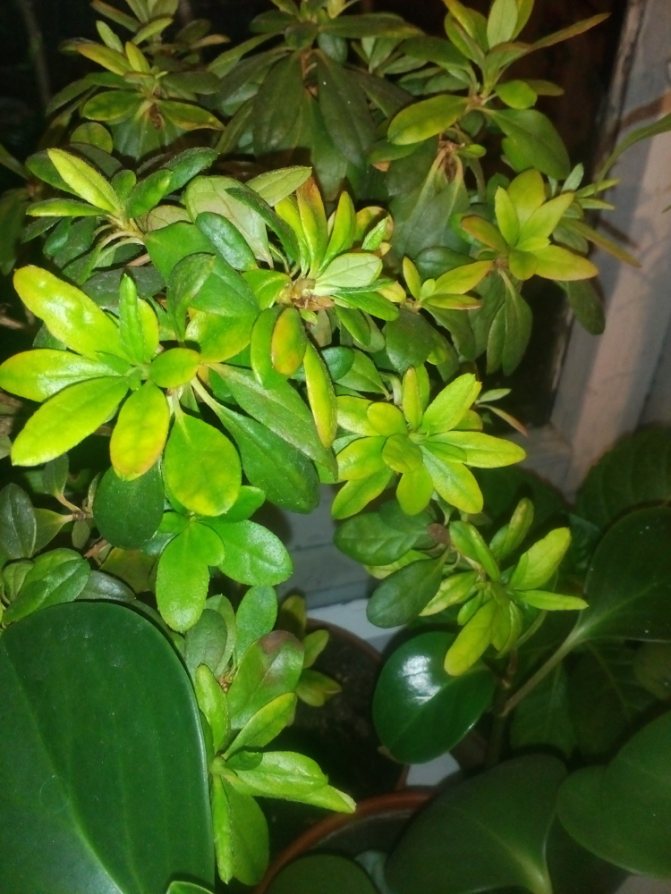Azalea - the main diseases and their treatment
Causes of azalea diseases, their symptoms (dry, fall off, black leaves), methods of treatment.
Why does azalea shed all its leaves in winter?
There are varieties of azaleas that shed their leaves after flowering. This happens mainly in winter. In this case, we are talking about the dormant period of the plant. The plant is transferred from a cool, darkened place, watering is reduced, feeding is not applied. The dormant period ends with the appearance of new leaves. If the azalea did not bloom, the leaves are crumbling on it, what should I do? In this case, the care of the plant is reviewed and it is brought in the desired parameters.
Recently bought an azalea. The leaves wither on it, although the color intensity has not lost. The buds also dropped, but did not dry out. Reason: lack of watering or reaction to high air temperatures. In the first case, you need to check how dry the earth in the pot is. With proper care of the azalea, the soil in the pot should dry slightly on top before the next watering. If the soil is completely dry in the pot, the azalea is dipped in a container of water for a few minutes (at least 15 minutes). Not frequent, but abundant watering is recommended for the plant. In this case, the soil in the pot must be completely walked with water, the latter stands out from the pallet. It is removed from the pallet. At elevated indoor temperatures, so that the leaves of the azalea do not wither, frequent spraying is recommended (at least 2 times a day). Otherwise, the azalea dries up and leaves fall off.

The azalea has dropped all the leaves. What to do? In this case, the leaves begin to turn yellow from below. Some twigs retain the green color of the leaves. Reason: waterlogging of the soil. As a result, the small roots of the plant decay. That is why the leaves of the azalea begin to turn yellow unevenly. To eliminate the problem, you need to carefully, without violating the integrity of the earthen coma around the roots, remove the azalea from the pot and check the condition of the roots. Healthy roots in the cut will be white, affected ones with a brown tint. Next, they wrap an earthen lump with newspaper and allow the soil to dry out for 24 hours. Then the plant is lowered into a pot, watering is normalized.
The spots on the azalea leaves are reddish in color.
Reason: high air temperature in the room where it is located, direct sunlight. The azalea should be shaded and kept in a low temperature room.
What to do - the leaves of the azalea dry up and the buds wither?
Reason: high room temperature, insufficient watering. Ways to eliminate the problem: to normalize watering and the temperature in the room where the flower grows.
Azalea - leaves darken. The color of the leaves will change, starting from the tips, gradually moving to the cutting
... Reasons: violation of the rules of plant care. This can be over-watering and the effect of cold air on the plant. It is necessary to provide azaleas with a normal microclimate, adjust watering.
Why do azalea leaves turn yellow on young shoots?
The reason is chlorosis. This is a lack of nutrients in the soil. Similar signs indicate an excess of calcium salts in the soil.Azalea should not be watered with hard water, only soft, purified water slightly acidified with lemon juice (concentration 1-3 drops per 1 liter of liquid). Treatment of the disease: carry out complex fertilizing of the plant. Fertilizer is used for azaleas and gardenias. You can do foliar feeding of azaleas.
Why do azaleas turn brown buds? The unopened buds of an azalea wither and dry out.
There may be several reasons. It is necessary to reconsider the conditions for caring for the plant. Azalea does not like waterlogging and drying out of the soil. From this, its small roots die. Normal watering is carried out as follows: before the next watering, the soil in the pot should dry out by 4 cm. Watering should be abundant, but not frequent, there should be no water in the pan. Brown buds are the result of dry air. Azalea should not be kept near radiators. The last reason is that the roots are tightly entwined with an earthen lump, the azalea lacks nutrients. It is necessary to carefully transplant it by transshipment, without violating the integrity of the earthen coma, into a pot with a larger diameter.
White bloom on azalea leaves. Formed on the back of the leaf, as a result, the azalea leaves wither and fly around. Reason: phomosis, akin to gray rot. Phomosis occurs with insufficient watering of the azalea and dry indoor air. Control measures: spraying the azalea with a solution of the drug Topsin-M (0.1%), foundation (0.2%). Re-processing after 10 days. Process 3 times.
Why azaleas fall off leaves and dry stems
... The reason is lack of nutrition.
(lat. Azalea
) Is a very beautiful plant from the genus Rhododendron of the Heather family. Flower lovers are fascinated by the contrast of its abundant, lush bloom with its bright green leaves. However, azalea can also upset its owners by being exposed to a large number of diseases and pests. The article discusses the main causes of azalea diseases and their treatment.
Did you know?
Beautifully flowering species and varieties of azaleas are native to China, Japan, Southeast Asia, Europe and North America.In eastern countries, azalea is a symbol of joy, peace and freedom.Azalea got into the culture more than 300 years ago. At the beginning of the 19th century, Captain Wellbank brought a beautiful specimen from India, which became the ancestor of a huge number of various hybrids and varieties bred by botanists as a result of long-term selection work.
Recovery methods: photo with description
It is difficult to restore a damaged plant, but it is quite possible. Patience, knowledge of treatment procedures and care give excellent results. Among the most common treatments are:
- transfer;
- soil replacement;
- soil renewal;
- pruning;
- spraying;
- darkening and lowering the air temperature.
In no case should you stimulate the blooming of an unhealthy Azalea, it is best to remove the ovaries so that all your strength goes to recovery. It is very important to quickly determine the reason why a beautiful bush is dying. This is the only way to find a competent solution to the problem.
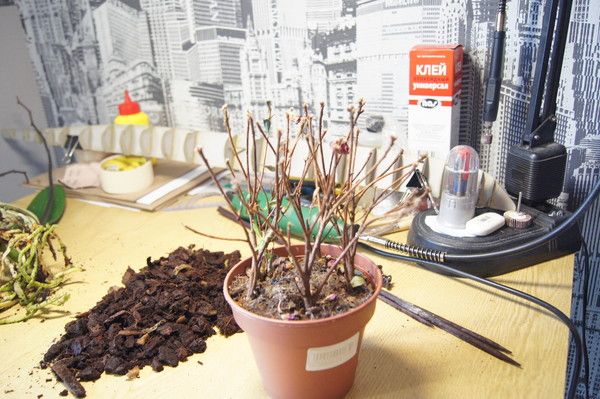

Dry plant care
Azaleas will need redoubled care after being successfully resuscitated. The conditions in which she will have to spend from 3 weeks to 2 months should be ideal for a weakened plant.
- The place where the container with the bush will be stopped needs to be shaded.
- The temperature should be lower than usual.
- Water the plant with a special solution: dissolve a few drops of boric acid or lemon juice in 1 liter of water.
- Watering - under the root or in a tray, at least once a day.
- A growth stimulant is watered or sprayed once a week.
- Twice a week it is helpful to water it with ice melt or rainwater.
Important! One of the most common reasons for the death of Azalea is the incorrect placement of the flower: a bush dies near the heating radiators, which dry out the air and soil.
Transfer
A dried or diseased plant is often recommended to be transplanted into a new, more spacious container with fresh soil. After removing all damaged aerial parts and processing the cut points of the branches, the bush is carefully moved into a new container.
If there is no suspicion that the root system is also damaged, Azalea is not taken out of the soil, but "rolled" into a new pot, filling the remaining space in it with a nutrient mixture for this type of indoor flowers.
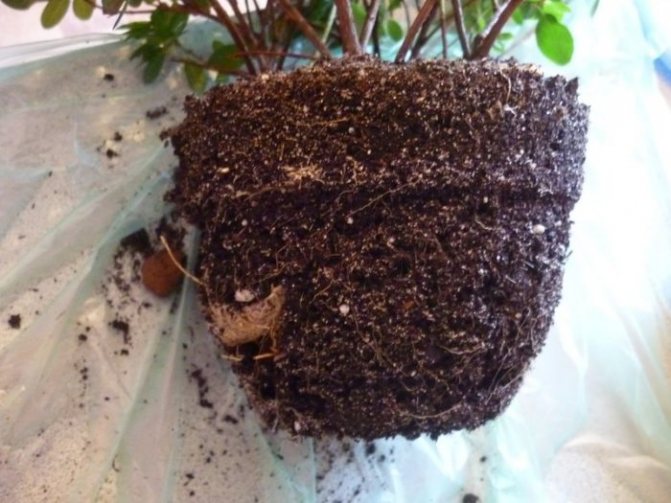

But sometimes more serious measures are required.
- Moisten the potting soil.
- Remove the earthen lump with roots.
- Remove damaged roots.
- "Bathe" the roots in a nutrient solution.
- Pour drainage from ceramic chips, pebbles, shell rock into the container.
- Pour in soil for Azalea, purchased in a specialized store, leaving at least 5 cm to the edge.
- Place the Azalea in the pot, carefully spreading all the roots.
- Sprinkle the remaining earth on top, compact.
- Water the plant well.
After that, it is worth placing the Azalea in a shaded cool place for 2-3 weeks so that the plant takes root well.
What to do if azaleas have white bloom, how to cure leaf chlorosis
Sometimes you can notice the white bloom formed on the back of the azalea leaves, after which they wither and fall off. The reason is phomosis, which occurs when the plant is not properly watered and the temperature in the room is disturbed. What to do?
Countermeasures are spraying the azalea with a 0.1% solution of Topsin-M and a 0.2% solution of Fundazole.
Re-processing is recommended three more times every 10 days.
Another problem with azaleas is yellowing of the leaves. The reason is chlorosis. A disease occurs when there is a lack of nutrients in the soil. Similar signs indicate an overabundance of calcium salts in the flower pot.
Treatment of the disease consists in the implementation of complex plant nutrition. Fertilizer is used for azaleas and gardenias. You can do foliar feeding of azaleas.
What can a room rhododendron suffer from?
Plant disease is a negative condition caused by viruses, bacteria, fungi, or improper care. Azaleas react to lack and excess of nutrients, the degree of soil moisture. Typical symptoms:
- drying of leaves and buds;
- discoloration, the appearance of spots;
- falling leaves and flowers;
- decay of roots;
- growth retardation.
Pests are insects that have settled on a plant. Phytophages feed on azalea juice, causing wilting, yellowing of leaves and deformation of buds. One of the dangers is the spread of viruses and fungal infections by pests.
How to treat azalea phylocystosis
Very often, flower growers wonder why the leaves of azaleas turn black. The formation of ash-gray with a brown border or dark brown spots on the leaves, from which sporangium balls fall, means that the azalea is infected with phyllosticosis.
To help the flower, a 0.2% solution of Fundazol and a 0.15% solution of Topsin-M are alternately used, and the damaged leaves are destroyed;
Did you know?
Getting to know an azalea can sometimes be dangerous. Its smell can cause severe headaches, and azalea leaves and shoots in drinking water can cause poisoning. This plant has another unusual property: if you cut off a branch of azalea and bring a lighted match to it, the branch will flare up, as if doused with gasoline.
How to reanimate after illness
Azalea diseases are the result of mistakes. They can be caused by changes in air temperature and humidity levels. If azalea leaves turn black, then the cause may be the Black Triassic or infection with fungal diseases.Septoria (red-yellow spots with black dots), cercosporiasis (brown spots with red edges on the lower side of the leaf), phyllostictosis (brown or gray spots) are characterized by the presence of spots that appear and grow on the leaves and stems of the plant. Late blight affects the roots, and it indicates the twisting and drying of the leaves, which first darken, starting from the very tips, change color, and then curl and.
Special drugs that need to be used as early as possible will not allow these diseases to progress: Bordeaux liquid, "Fundazol", "Ditan", "Topsin-M" or other fungicides. With verticillosis, the base of the stem darkens, and not the leaf, this can rather lead to death. Timely treatment with copper sulfate or fungicides will save you. The sooner the disease is established, the sooner treatment will begin, which means there will be more hope for the complete recovery of the plant.
After using special preparations, it is necessary to destroy all affected parts of the plant in order not to give the disease a chance to return. An azalea that has undergone illness needs recovery procedures no less than after an invasion of pests or drying out due to poor care. The main goals are the same: restore immunity, improve conditions, and help absorb nutrients.
Azalea is certainly transplanted into new soil, be sure to check the condition of the roots. Then apply frequent watering and spraying with water with boric and citric acid alternately, sometimes using Elina solution to enhance immunity.
It is important that at this time the air temperature does not rise above + 20-22 degrees, and the lighting is soft without direct sunlight.
Azalea leaves have dark brown spots, treatment for gleosporia
If dark brown and / or gray spots appear on the leaves of the azalea, as well as traces of blackening, we can safely diagnose gleosporia. The cause of this ailment may be damage to black thrips, rhododendron tick, fusarium disease.
In the case of black thrips, the plant is reanimated with the help of the Karbofos emulsion, if a rhododendron mite appears on the azalea, the Fundazol solution will help. With fusarium will help the drug "Diazinon".
Important!
Azalea reacts negatively to dry air, so keeping the plant close to heating devices is strictly prohibited.
Insects and control measures
A common cause of illness and death of azaleas is the appearance of pests:
- Rhododendron bug - winged insect 3-3.5 mm in size. Lays eggs on the back of leaves, covering them with resinous secretions. The adults and larvae suck out the plant sap. The leaves turn yellow and curl. Pests are destroyed by insecticides "Decis", "Fury".
- Mealybug - the body of the parasite is covered with a white waxy coating. It affects all parts of the plant. The secretions of worms contribute to the spread of sooty fungi. Control measure: treatment with Actellik.
- Weevil - adult beetles eat the edges of leaves, buds and buds. The larvae in the soil damage the roots. Against the weevils are used means - "Bazudin", "Aktara".
- Beater - the beetle eats the leaves, leaving only the veins. Means of struggle - "Diazinon".
- Slug - feed at night on young plants, eating the rudiments of leaves. Insects are collected using traps, "Mesurol" is used.
- Thrips - greenhouse or black thrips eat azalea leaves. Due to damage, they turn yellow and fall off. The insects are taken out with the Karbofos solution.
- Moth - the pest of the bush is the caterpillars of the azalea moth. They feed on and pupate on the leaves. Fumigation and spraying with sulfur are used against the pest.
- Fly - rhododendron fly is a specific pest that sucks juice from leaves. They get rid of it with nicotine sulfate.
- Aphid - small insects live in colonies.Their vital activity slows down the growth of bushes, leads to a delay in flowering. Aphids carry viruses. In the fight against the pest, "Karbofos" and "Actellik" are used.
- Whitefly - a butterfly sucking out azalea juice. The plant lags behind in growth, withers and dies. The bushes are washed with soapy water and sprayed with Aktara.
- Mite - on azaleas are parasitized by 3 types of ticks - red, strawberry and spiderweb. Adults and larvae damage the tops of the shoots, flowers, leaves. Pests hide on the back of the leaves, making it difficult to spot. Actellik is used to kill ticks.
Watch a video on what pests affect azalea and how to deal with them.
Azalea necrosis
With a significant decrease in air temperature in azaleas, the main axis of the leaf dies off, and from above it acquires a brownish tint, which signals the appearance of necrosis.
There are varieties of azaleas that dry and fall off after flowering. This happens mainly in winter. In this case, we are talking about the dormant period of the plant. The flower is transferred to a cool, darkened place, watering is reduced, no feeding is applied. The dormant period ends with the appearance of new leaves. If the azalea has not bloomed, but leaves are crumbling on it, then it is necessary to reconsider the care of the plant. Therefore, we recommend choosing frost-resistant flower varieties.
When do you need to revive a flower?
Salvation of the plant will only help if it has not yet completely died. First of all, it is necessary to examine the azalea: are there living buds or sprouts on it. In this case, it is necessary to take action as soon as possible, and then soon the flower will come to life again and will delight its owners.
Resuscitation can be carried out in case of falling, wilting or yellowing of leaves, pest infestation.
Azalea: disease prevention
A plant, like a person, requires constant increased attention. Therefore, azalea owners are advised to carry out simple prophylaxis in the early stages of azalea growth by treatment with copper chloride (the most sparing dose) - it kills up to 90% of fungi, Fundazole solution (the period of immunity from the appearance of new fungi up to 25 days) and apply organic fertilizers that improve protective plant functions.
If the azalea has dropped its leaves, it is unlikely that the grower will be in a good mood. However, both the beginner and the professional are obliged to understand the reasons for this behavior of the plant and the available methods of dealing with this. Different information makes everyone wiser. Therefore, the replenishment of the piggy bank of knowledge is the goal of every person.
Why do the leaves of the flower dry and fall, what factors become the main ones in this process and how not only to cure the plant, but also to avoid such problems in the future with azalea? Everything is described below.
How to determine the cause of the disease?
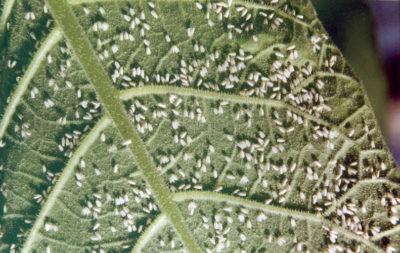

Noticing a deterioration in the condition of a houseplant, you should carefully examine it and the soil in the pot. If small phytophagous pests are found, then you need to fight them. Usually insects are found on greenhouse and garden specimens, but they also get into the house without problems. In other cases, agrotechnical care is reviewed and the symptoms of the disease are studied.
To establish the cause of the disease, you must:
- Consider all agrotechnical factors:
- watering frequency;
soil composition;
- top dressing;
- temperature;
- humidity level;
- illumination.
- Study the signs of fungal infections and the effects of pests, compare them with the state of the plant.
Deviations from the recommended norms for azaleas lead to a deterioration in the condition of the plant.
Attention! When diagnosing a disease, it is necessary to consider all the symptoms and the dynamics of their development.
Features of azalea
Not only flower growers receive positive emotions from plants that live in their house or garden, but also guests and just passers-by.Delight from blooming "plantations" on window sills and in stands near them, on a personal plot and a flower bed near the yard can give a very positive mood. True, the disease of any plant can spoil the mood, and only one thought remains, how to save the flower.
Such a finicky plant as azalea is not recommended for beginner flower lovers. The reason is that it has “grievances” in almost every area of care. Having the skills to develop different types of flowers, it is no longer so difficult to pay due attention to this plant.
Therefore, if the leaves of the azalea began to turn yellow and even more so to dry, you should find violations in the correct care.
Before starting this plant, you need to know what it prefers and what it does not perceive.
Most of all, azalea will be "pleased" by clean water and coolness. Based on this, it is necessary to harvest distilled or purified water that has been settled for 3 days, as well as rainwater. Put the bloom on any window sill with a shade, only so that it is not on the south side.
In the cold season, the plant is carried away from heating appliances. Excessive heat, like a cold snap, is contraindicated in a flower. Azalea is protected from temperature fluctuations lower or higher than 12 - 20 degrees Celsius. If flowers appear on the plant, then temperature optimization should be ensured. The ideal option would be +15 degrees Celsius.
The reasons why leaves fall off are dryness and excessive heating of the air.
Moreover, if, among other things, the flowers wither, then the plant is often exposed to sunlight. If the humidity drops, then the leaves fall off. Experienced flower growers increase humidity not only with stationary or mobile air humidifiers, but also with improvised means. A pallet filled with wet expanded clay or moistened peat, as well as spraying three or four times, will give the same effect.
The heating season is also not good for the plant. The azalea should be saved all the time by sprinkling the leaves on it. It is worth saying that if it blooms, it is forbidden to do so. Its flowers, unlike leaves, do not like being moistened with water. Then you should pay attention to the constant moisture of the soil, as well as increase the percentage of moisture in the air.
If the azalea is completely lethargic, from leaves to buds, and the latter appear on it less and less, then attention should be paid to the soil mixture. Most likely the reason is a decrease in the amount of nutrients and trace elements.
Preventive measures
To avoid drying and falling of azalea leaves, it is recommended to carry out preventive measures in the form of:
- regular application of mineral fertilizers;
- watering the plant with water at room temperature;
- use only soft, high-quality water for irrigation;
- use for transplanting acidic soil;
- preventing temperature changes and overheating of the plant;
- preventing air dryness through regular spraying;
- placing the pot on windowsills with a light shade;
- timely processing of a flower from pests and diseases;
- disinfection of tools for pruning shoots or roots;
- regular indoor cleaning and ventilation;
- timely removal of diseased, dry shoots and buds.


To prevent the azalea from dropping foliage, you need to remember the rules for caring for it and avoid mistakes that can provoke this problem. However, if this happened, after identifying the cause, you know what to do.
Rescue of a whimsical azalea and ways to get rid of problems
How to save a dying plant in types, methods, sequence of actions, causes of occurrence is described below. Let's consider each situation in more detail.
If the azalea has thrown off all the leaves, and its branches are actively drying up, it means that the plant is in danger of death.
Cause
is covered:
- in violations of the root system;
- after rearrangement;
- in the face of unexpected stress;
- inappropriate transplants into a new pot in conditions of flowering plants.
Pests can also be the culprit. It is necessary to cut off everything dry to those places where there is still living tissue, and then diligently monitor the condition of the bush.
Leaves can dry out or wrinkle due to insufficient watering or humidity. In this case, the overdried soil underneath it must be quickly saturated with moisture. To do this, it is enough to lower the entire pot with the plant at the base into cool water collected in a container. At the same time, one should not forget that moisture absorbed by overdried soil should not have increased hardness indicators. In this case, the water should be boiled and cooled, or use a settled flowing liquid.
The reason why yellow foliage is observed in azaleas may be chlorosis. This means that the earth is alkalized with calcium. The solution is simple - it is watered with acidified water with a temperature of no more than 15 - 16 degrees Celsius.
The leaves turn black, or rather, growing dark red and brown spots appear on them, when the plant is infected with septoria. It's a fungus. For him, conditions of high humidity and warmth are best suited. The period of occurrence is spring. The salvation is the treatment with chemicals. Prevention - compliance with the requirements for plant care, as well as prevention of excessive scarcity of representatives of indoor flora.
If the young leaves dry up, and the adults not only turn yellow, but also crumble, and brown spots appear on the surface of both, then the flowering has undergone a disease.
Often, in addition to the previous signs, over time, there is a feeling that the leaves are covered with sticky syrup. The scabbard can suck out the strength of the plant, feeding on its juices. A form of struggle in the midst of the disease for azalea - treatment with an insecticide, at the beginning of the lesion - "washing" each leaf with soapy water.
Leaves can also fall off due to the defeat of the plant by a spider mite. A thin cobweb is visible in the internodes of the stems. The leaves change their appearance, often curling into tubes and begin to crumble. The buds dry up. The reason for the appearance of a harmful insect is excessive dryness of the air, as well as a long absence of spraying. They fight the problem that overtook the rhododendron by spraying the plants with clean water and washing the foliage with soapy water.
Falling, as well as curvature of the leaves, occurs due to the defeat of the azalea by another problem. Mealyworm deals very strong damage. The insecticide again becomes a rescuer for the bush.
If the tips of the leaves, especially the young ones, are affected, you should look under them. The problem is most likely due to aphids. The pest can be destroyed by “washing” the bush with soapy water.
What to do depending on the reason?
Depending on the reason for the drying and falling of the leaves, appropriate measures are taken, therefore, we will consider what needs to be done and whether it is possible to save the flower from death:
- If the cause of the development of problems is improper care, you should identify the main errors and correct them, taking into account the recommendations for care. With regular excessive watering, which led to decay of the root system, the plant should be transplanted into new soil and rotted roots should be removed by sprinkling the cut with crushed activated carbon. When transplanting with partial removal of the root system, there is a possibility of plant death, since the azalea does not tolerate trauma to the roots. A forced measure in the form of a transplant is necessary to save the plant from rot, which will eventually destroy it (first, the roots will rot, then the ground part will also dry out).
- If the plant has suffered from improper maintenance conditions, you should change the location of the pot, in accordance with the recommendations for the placement of the azalea. The affected parts or leaves (for example, burnt leaves) are removed.
- When the azalea was hit by stress, and all or almost all of the leaves have already fallen off, you need to put a plastic transparent bag on the pot and fix it with an elastic band from below. Such conditions will create moisture, which will stimulate the growth of new sheets. Watering for the recovery period is suspended, since the soil does not dry under the package. The bag is removed after new leaves appear on the shoots.
- If the azalea actively sheds its leaves after transplanting during flowering, to restore the deciduous part, the plant is placed under a transparent plastic bag. At this time, the soil is not watered. When new buds appear, the flower is freed from polyethylene.
- Damage to azaleas by pests requires taking measures to destroy them: from the rhododendron bug they treat with "Decis", from the scabbard - "Fitoverm", from the rhododendron fly - by spraying a solution of nicotine sulfate, from the whitefly - "Aktaroy", from the spider mite - "Aktellik". All drugs are used according to the instructions, observing the dosage when preparing solutions.
What leads to azalea diseases
In the case when the azaleas first fold, and then the leaves dry, then the problem lies in the defeat of the bush by moths. You won't have to look for her for a long time. It looks like a spindle-shaped caterpillar. The sequence of actions to combat it is quite simple - collecting the moth and treating the plant with a chemical (issecticide).
Azalea also dries up due to a long-standing defeat by the rhododendron bug.
It was probably overlooked a little earlier that discolored spots appeared on the leaves by a rhododendron bug, which itself is 03, -0.4 cm long. Eggs are laid on the underside of the leaves. The overwintered new generation hatches in the tissues of the plant and continues to actively damage the bush. You can save the azalea with diazinon.
If your favorite azalea sheds its leaves, but not in the way described in previous cases, what any experienced florist knows to do. In the case when the plant has fusarium, the whole process is accompanied by a number of other signs. Among them, the change in the appearance of the foliage, its blanching, then yellowing, twisting and wilting, stand out separately. The kidneys turn brown and die. Fusarium first appears in a pot, at the roots. The reason is too humid environment and a significant excess of the required thermal regime.
Rescue treatments:
- antibiotics;
- fungicides;
- copper sulfate, followed by processing with potassium permanganate after 14 days.
Noticing that the "potted beauty" has turned black in the form of irregular angular brown spots with a red canvas below the foliage, one can guess that the plant has cercospora. At the same time, a gray bloom is noticeable on top of the foliage.
If spots of ash-gray and brown color appeared on top of the edges, it means that the plant got sick with phyllostictosis.
In both cases, you should resort to the use of fungicides, as well as reducing moisture, including reducing the number of watering and spraying.
Throwing off the leaves, the bush informs the owners of the problems. Accompanying signs indicate which ones.
If the "fussy" threw off the greens, it means that she was not satisfied with the level of care, and she decided to cheer. The "capricious lady" from the world of flora is worth courting. And then, in return, she will delight with her beauty.
When azalea sheds leaves, why this happens should be known in all variants, as well as how to understand and follow all the conditions for caring for this plant. Periodic examination, removal of damaged areas, timely treatment prevent her death.
Everything you need to know about when and why azalea dries is outlined in this article. This plant only feels comfortable if it receives a lot of attention. And compliance with all care requirements will be expressed by the abundant flowering of the bush.
Azalea is one of the most beautiful indoor and garden plants that can decorate any interior or garden with its lush flowering. Azalea flowers can be simple or double, corrugated, fringed and have a wide variety of colors. This plant is quite capricious and flower growers have a lot of questions when growing it. Sometimes it happens that the grower simply does not know what to do if his azalea has dropped the leaves. How to save the plant and why do the leaves dry?
Determination of plant ailments and parasites
A plant disease is understood as a change in its state under the influence of the pathogenic activity of bacteria, viruses or fungi.
The cause of the disease is often poor-quality care, in which the green pet suffers from a deficiency or oversaturation of useful microelements and moisture.
To suspect the development of a disease in a plant allows:
- decreased growth rate;
- change in leaf color, including the appearance of spots;
- drying out;
- falling of flowers, buds, leaves.
Pests are insects that feed on plant sap... In order to get to the valuable moisture, phytophages damage the leaves and buds of the azalea, causing them to wilt and fall off. Insects often become carriers of fungal or viral infections.
Diseases and their treatment
Azaleas most often dry and fall off the leaves due to the appearance of various diseases. Azalea is very susceptible to various diseases if not properly cared for. It also happens that fungal diseases appear due to poor conditions of detention - low humidity, cold, lack of light, etc.
If the azalea leaves turn yellow and fall off, the stems and roots have begun to fade, it means that the plant is sick with fusarium - a fungal disease. The main symptom of the disease is a pinkish bloom that appears on the root collar. Treatment consists in isolating the diseased plant from others and in treatments with foundation.
If brown spots of various shapes and sizes appear on the leaves of the plants, it means that the flower has fallen ill with Alternaria. To cure this fungal disease, you should treat the azalea with Bordeaux liquid several times.
Very often, azaleas suffer from septoriasis, in which the leaves dry and fall off. First, black specks appear on the foliage, and then all the leaves can fall off. The cause of the appearance of this disease can be too late feeding of the plant with nitrogen fertilizers. Also, too abundant watering and pruning not done in time can cause septoria. In this case, fungicides are used to treat flowers.
Sometimes on the leaves of azaleas appear ash-gray specks with a brownish border. This means that the plant is sick with phylostikosis. Fundazol is used against this disease, as well as Topsin-M. it is best to take the two drugs alternately. Damaged leaves should be destroyed.
If the leaves of the rhododendron begin to curl, dry and fall off, then the plant is ill with late blight. In this case, the azalea must be treated with Bordeaux liquid or phytoverm. It is also desirable to improve the permeability of the soil in the pots.
Why does the flower die?
Azalea usually loses strength, withers and slowly dies due to improper care. This is most often caused by traditional adverse factors:
- irregular watering;
- excess moisture;
- high or low air temperature;
- burns on the leaves from direct rays of the sun;
- azalea does not receive light and nutrients (no feeding);
- planting in unsuitable soil.
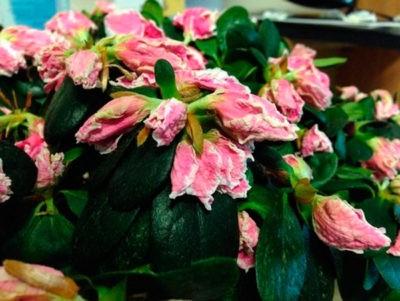

Azalea can also die with severe pest infestation: moths, bedbugs, ticks. In stressful situations (a sharp temperature drop), the plant begins to dry out. Azalea is not afraid of low temperatures (up to + 10 ° C) only if it is preliminary hardened.For successful rehabilitation, it is important to accurately determine the cause and relate it to the symptoms.
- Dry leaf edges, brown spots - a sign of waterlogging of the soil or dry air.
- Dry spots on foliage - a sign of insufficient watering, soft - frequent.
- Falling green foliage occurs in a stressful situation, with drafts, watering with cold water.
- Loss of color due to lack of lighting or excess nitrogen.
- The green parts of the azalea turned pale - the plant lacks nutrients.
Read more about azalea diseases and pests here.
Pests
The succulent foliage of azaleas is very fond of various insect pests that can cause the death of the plant. If the old leaves began to turn yellow, and the young leaves fade and fall off, and small dots are visible on the leaves, then this is a sure sign that a scabbard attacked the azalea. This pest sucks the juice from the flower, which gradually leads to its death. The leaves change their color every day, become covered with a sticky and shiny substance, as if syrup. If you do not process the azaleas from the scale insect in a timely manner, they will die. To get rid of the pest, the plant must be treated with insecticides. But if the scale insect is still small, then you can try to get rid of it by wiping each leaf with a solution of laundry soap.
Photo
In the photo below you can see what the yellowing and drying of the foliage of the indoor rhododendron looks like.
What to do if leaves fall off a garden azalea
It is generally accepted that azalea is only a houseplant. In fact, many varieties have been bred that can be successfully grown in open ground in the garden. But usually this flower is grown in warm regions with mild winters.
If the azalea suddenly threw off the leaves, what to do? Many novice flower growers simply do not know what to do with their pet. Azalea is a rather complex flower, and for its successful cultivation, you need to know what types of this plant exist.
Please note immediately that deciduous varieties of azaleas have been bred, which shed their foliage in the fall. So the plant leaves during the dormant period, and in the spring young leaves will appear on it. It is very simple to determine that you have a deciduous azalea - the leaves before falling off in deciduous species turn yellow, red or turn purple.
Video "Why Azalea Withers"
In this video, you will learn how to cure an azalea that has begun to fade.
Azalea home - the collective name of varieties originating from two wild species of azaleas - Indian and Japanese. Currently, the genus Azalea is included in the genus Rhododendron, all representatives of which have decorative flowers and need special growing conditions.
Violation of the rules of care leads to the fact that the plant quickly loses its decorative effect, the leaves turn yellow, turn black or dry out, and then fall off. Incorrect growing conditions lead to the fact that the azalea weakens, its resistance decreases, and it becomes a target for diseases.
Factors causing the azalea to shed its leaves can be:
- mechanical;
- chemical;
- biological;
- physiological;
- climatic.
Sometimes, several reasons act simultaneously, for example, inadequacy of the climate and damage by pests or infection, to the fall of foliage.
Physiological factors
When growing rhododendrons, you need to remember that these are seasonal plants, and even with proper care, the absence of diseases and good health, homemade azalea partially loses its foliage. This is a natural process - after all, even evergreens must renew the foliage. At the same time, varieties derived from Japanese azalea (Japanese rhododendron) lose more leaves than varieties whose wild ancestor was Indian azalea. Natural or physiological loss of foliage, in a healthy plant, occurs after flowering, during a dormant period.Internal metabolic processes in tissues slow down, but the foliage of the azalea falls off only partially. In this case, in place of the fallen leaves, dormant buds are formed. With the beginning of the growing season, new leaves develop from these buds, which will last the plant for 2-4 years.
Watering should be abundant
It is necessary to water the plant abundantly, but at the same time, the soil should not be waterlogged. In the fall, when the budding process is in progress, watering should be significantly reduced.
But in the summer, you can recommend special water procedures for azaleas. Once a month, place a flower pot in a bucket of water for 3-4 hours. Then you need to let the plant settle so that the excess liquid is gone, and return the pot to its original place on the windowsill.
It is best to take rainwater, thawed (from melted snow) or distilled water for irrigation. Tap water can only be used after it has settled well (ideally at least three days), even better if it is boiled. We must not forget that the plant does not like but prefers, on the contrary, soft. You can soften the water not only by settling or boiling, but also by adding peat or various chemicals that are sold in stores.
Watering conditions must be strictly observed, otherwise you may see the azalea shedding leaves. What to do?
How to make it bloom?
Why does indoor azalea not bloom at home?
Azalea is capricious it is difficult to make it bloom
(it is advisable to know when it should bloom in time).
What if the azalea is not blooming?
To make the azalea bloom you need to pinch the top
and young shoots. More often in June, the flowering of azaleas ends, in the summer you should carefully monitor the watering, apply fertilizers 3-4 times. stimulating flowering (from June to September).
During the flowering period, you need to spray with cool water, place in a tray with wet expanded clay.
Azalea is a capricious plant
however, its beauty will make up for effort and time. spent on care. Beautiful flowers will be a well-deserved reward for the comfortable conditions created for the azalea.
Destructive leaf fall begins if the proper care of this capricious plant is violated.
... If your flower has completely lost its leaves, you need to take it urgently. Otherwise, the azalea will die from lack of adequate nutrition.
By the appearance of the foliage, one can judge the health of the bush.
Climatic factors
Azaleas prefer to grow in cool places with high air humidity (70-82%). At high temperatures (over 20 degrees) and dry air, azalea sheds leaves and flowers. And also stops laying new flower buds.
How to avoid:
contain azalea at high humidity and a temperature of 12-16 degrees, during the flowering period, during dormancy, the temperature is still reduced (but not lower than + 5).
Insufficient watering, or lack of it for a long time, can also lead to the fact that the azalea shed its leaves. In this case, you need to shorten the shoots a little and resume watering.
Humidity won't hurt, but will help
The flower prefers high humidity, which means that it must be provided. First, place the pot with the plant on a pallet with expanded clay, which must be constantly wet. It is useful to periodically rinse expanded clay under running water. Secondly, home care for an azalea requires constant spraying. It is advisable to do this daily, and in hot weather - twice a day. During the flowering period, spraying is not necessary so that spots do not appear on the flowers.
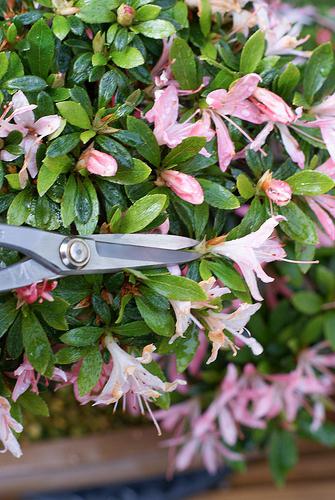

Remember that a lot of dry air with central heating can often answer the question: "Why does azalea shed its leaves?"
Cutting is not easy
If you prefer not to buy an azalea in the store, but to do its own reproduction, then you should immediately tune in to the fact that everything will not be so simple.
Only young shoots that are not yet stiff are suitable for cuttings. With a sharp knife (blade), a 10-15 cm stalk is cut off under the kidney. It is placed in a container with wet peat and deepened by about 5 cm, the soil around it must be tamped. Then the handle is closed with a jar or plastic. You can also place it in a greenhouse. For rooting to occur faster, high humidity and a temperature of +25 degrees are required.
Cuttings will not rot if they are ventilated and sprayed at least three times a day.
The rooting of cuttings will have to wait for a long time, up to six months. Then they are transplanted into a pot, to a permanent place.
For reproduction, you can still try to root the layers of this plant. An incision must be made under the bud on the lateral shoot. With a wooden hook, this shoot is pinned to the ground and sprinkled with soil. By the way, there should be at least a few leaves above the bud.
When the shoot takes place, the cuttings are carefully separated from the main plant and transplanted into a separate pot.
Causes of yellowing of leaves. How to fix the problem
There are two main reasons for the appearance of yellow leaves and their further fall:
- The development of chlorosis, which is a consequence of the increased calcium content in the soil. You will see that the azalea suffers - the leaves fall. What to do to solve this problem? Everything is quite simple: you just need to slightly acidify the water with which you water the azalea. At the same time, do not forget about the comfortable water temperature, which should be around 15-16 ° C.
- The presence of a thyroid gland on the surface of the plant. This insect leaves brown plaques on the leaves. In the future, this leads to the fact that the color of the leaves fades, a sticky bloom, shine is formed, and soon the leaf falls off. The method of insect control depends on the stage of the lesion. At the initial stage, the azalea needs to be treated with a soapy solution. For more complex lesions, the use of special chemicals is required.
Chemical factors
The cause of a toxic burn in a plant may be a poisonous substance accidentally trapped in the substrate or on the foliage. But usually, rhododendrons receive chemical burns from excessive irrigation with fertilizers. Symptoms of an excess of chemicals can be that the azalea sheds its leaves, and sometimes dries up and dies.
Azalea should be fertilized very carefully, guided by the rule: "lack of feeding is better than excess."
Another chemical factor is soil acidity. All members of the Heather family need very acidic soil - pH 3.5-4.5. With water, the components of the soil are gradually washed out, and the substrate changes its acidity, becoming slightly acidic or neutral. The plant does not receive the necessary root nutrition, since the microscopic soil fungi that provide the life of the azalea die. As a result, azalea leaves fall and flowers do not form.
How to avoid
: the plant should be watered with slightly acidified water, or special microelements.
Top dressing to help the plant
In order for the azalea to develop well and delight others with its flowering, it must be fed. Fertilize once a week from February to August. It can be ammonium nitrate, superphosphate, or In winter and autumn, superphosphate will not interfere, it promotes good budding.
To maintain the desired value, from time to time, for example, once every two weeks, the plants can be watered with a citric acid solution. To do this, dilute 1 teaspoon of acid in two liters of water. Another way to acidify the soil is to water the flower with a solution (0.2%) of sulfuric acid after 3-4 months. Each time this should be done only after the soil has been moistened.
There are special fertilizers used to feed flowering plants. This, for example, "Kemira" or "Ferovit". They are used as a means of preventing various diseases.
Transplant and pruning
Transplanting a bush will need to be done after it has completely faded. A new, not very deep container with drainage holes is selected. You can buy special acidic soil for azaleas at a flower shop or prepare your own by mixing:
- rotted coniferous soil - 2 parts;
- moss - 1 part;
- river sand - 1 part.
Too long roots are cut off when transplanting an azalea. The transplanted bush must be cut off immediately so that the plant takes root faster and blooms well in the future. To do this, the tops of the new shoots are pinched, and the faded stems are cut off. Brown leaves are removed.
Young azaleas are transplanted annually, and mature plants every three years. If the transplant is not done in time, then the overgrown roots form stagnant moisture in the pot and rotting of the soil. Various parasites and diseases will begin to appear.
Home care for azalea
Any flower loves good care. What can we say about the most exotic of them, those who are unfamiliar with our climate and other growing conditions? Therefore, it is very important for such plants, as far as possible, to create conditions that are more or less close to their relatives.
Requires its correct placement in the apartment. She loves bright diffused light or even partial shade, but does not tolerate hot sunlight. Of course, it is good to take the plant out to the balcony in the summer, but one must beware of drafts and sunburn.
The temperature in the room where the azalea is kept at home should be low: 16-18 degrees Celsius in the summer, 12-15 degrees in the winter. Indoor plant lovers have noticed that at the time of the setting and development of flower buds, that is, in the fall, it is best to reduce the temperature to 8 or even 5 degrees. This means that the azalea can be kept on a closed loggia for a long time, and then moved to the west or north window in the apartment.
A warning for beginner growers: if the room is too warm, besides it is very dry, the flowering time of the plant is shortened, and the azalea sheds its leaves.
How to save if the leaves have fallen?
Why does the azalea disappear (fall off): dries and sheds leaves?
Reasons that caused falling leaves,
may be different.
What if the azalea has dropped (thrown off) all the leaves?
To save the plant, bare branches should not be pruned. If the roots are intact, you need to spray the crown solution of the drug "Elina"
to restore immunity. In a pot, you can create a mini-greenhouse, thereby creating favorable conditions for the plant.
After the young leaves appear, you can prune the branches.
What to do when leaves fall
It is advisable to know at least something about rhododendrons before settling them at home. Azalea, due to the complexity of care, is called a capricious beauty. But if she settles in comfortable conditions, she will delight the owners with a healthy look and lush flowering. You just need to build care for her so that everything is balanced.
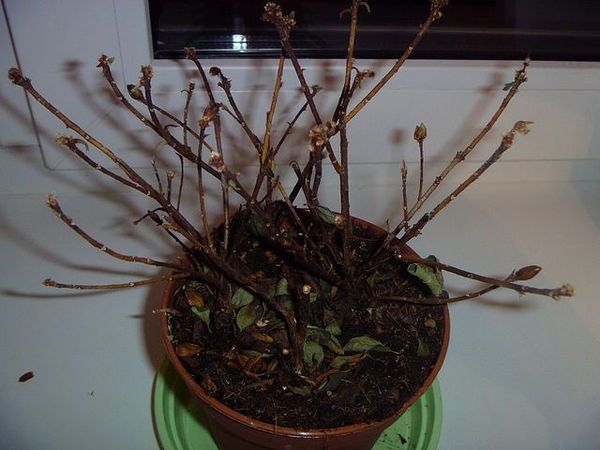

Azalea feels great when the air temperature does not exceed +22 ° C in summer and +15 ° C in winter. In this case, it should be sufficiently light, but without direct sunlight. It should be humid in the pot and in the air (80%), but you cannot spray during flowering. The soil needs acidic. Trouble begins when these conditions are violated.
If the leaves begin to dry out, change color, become covered with spots, you need to find out why this is happening and eliminate the cause. Leaves can fall off very quickly. They turn yellow as a result of an attack of pests - then you need to quickly take action. And if a lot of calcium has accumulated in the soil, then adding a little citric acid to the water will help.
The main reason for leaf fall is excessive dryness and high air temperature. As soon as the greens begin to dry, you need to lower the air temperature (this way the plant will recover more easily), water with settled acidified water, spray the flower.
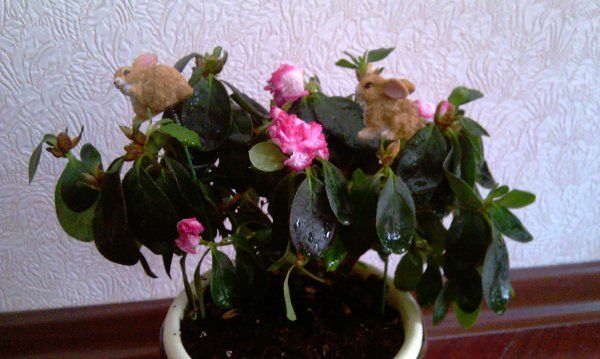

If the azalea dries, give it a cool shower. Most likely, tap water contains a lot of salts and unnecessary impurities (that is why it is defended), so you will have to use a watering can with a fine sieve to bathe it with clean, settled water with the addition of citric acid. You can immerse the pot in a bowl so that the water is 2 cm above the edge, leave it for 20-30 minutes, then let the excess water drain. Just fill the flower with acidified water!
Fungal lesions and infections
Excessive watering, lack of drainage, disturbed temperature conditions provoke fungal infections. Fungus infestation often occurs through the soil. If you have symptoms of fungal infections, be sure to isolate the azalea from other indoor plants. It is best to disinfect the windowsill and plant pots.
Alternaria
A characteristic sign of azalea alternaria is the appearance of dark red spots of various sizes and shapes. To combat this type of defeat, a solution of Bordeaux liquid is used as a fungicide.
Botrytis, gray mold or mildew
Gray rot caused by fungi of the genus Botrytis develops on the leaves, stems and buds of an azalea. Vague brownish-brown spots are a symptom of the disease. Damaged plant tissues dry out in a short time. Poor air circulation in the room may be the cause. As a control measure, a soap solution is used and treated with insecticides.
Root rot
Late blight spreads to the stem and leaves of the azalea, which contributes to the complete decay of the plant. Signs: kidney death and leaf rolling. High humidity and high temperatures may be the cause. Bordeaux liquid and Fitoverm are used as a control measure at the initial stages.
Anthracnose or rust
The disease is more common in tropical climates, since anthracnose develops at temperatures above 23 ° C. Red, brown, or yellow swelling is characteristic. The leaves of the affected plant fall off. For treatment, spraying with preparations containing copper is recommended. For example, Bordeaux liquid.
Cercosporosis
In cercosporosis, angular brown spots with a dark red rim can be seen on the underside of the leaves. A gray coating forms on the top of the leaf plate. The leaves of the lower tiers are more affected. Treatment consists in the alternate use of Ditan M-45 and Fundazol.
Powdery mildew
The main reasons for the appearance of this azalea disease are poorly circulating humid air and sudden changes in temperature. A white or reddish powdery coating forms on the affected parts. Infection begins in the lower tiers of leaves and gradually spreads to the entire plant. For treatment, you can use a soda solution, as well as fungicides (dosage according to the instructions).
Sooty mushroom
It mainly affects weakened and young plants. Often a sooty mushroom settles on the sticky secretion of azalea pests - whitefly, aphids. Colonies of sooty fungus contribute to the death of the affected parts of the azalea. The leaves are covered with a dark gray bloom. For prophylaxis, regular ventilation is necessary, for treatment - a soap solution and treatment with fungicides.
Difficulties in growing
Experienced growers know how finicky the azalea is and how often it gets sick when the climate, soil or care changes. That is why it is difficult for beginners to keep track of it without experience and skills. This flower blooms well and develops with proper care in compliance with all conditions, and at the slightest change it begins to react. Often sick, sometimes even without changes in the environment.
The plant should be kept cool, it is advisable to use filtered water. Recommended to be placed on windows where the sun is most. It is necessary to shade, direct rays are harmful.
The temperature for normal development ranges from 12 degrees and does not exceed 20. This is difficult to achieve without thermal control. When the temperature drops, the plant freezes, and when the temperature rises, it bakes. Hence the first diseases, which almost always manifest themselves especially sharply. Dry and brittle leaves are the first sign of a disease, a change in developmental conditions.
The most common fungal diseases
If the azalea disappears for no apparent reason (the absence of insects on the leaves, damaged areas and feces), then, first of all, it is necessary to pay attention to the fungal diseases. They progress at low temperatures in summer and high humidity, they are almost impossible to avoid, so you need to prepare all the "weapons" to fight these invisible enemies.
- Like fruit trees, flowers can hit Late blight.
This is root rot, which occurs when a pathogen enters the plant tissue. If the azalea curls into a tube, the leaves turn brown and turn black over time, then the plant must be processed immediately.
Chloridecopper
or
Burgundy liquid
... Copper-containing preparations do their job very well in the early stages, in the later stages of the disease, when the leaves are already turning black, nothing can be done. As a preventive measure, it is necessary to drain the top layer of the soil, to aerate the soil - this significantly reduces the risk of late blight. - Mixed chlorosis
leaves. A fairly rare disease that manifests itself in too humid weather. If a white bloom appears on the leaves of an azalea, then you should pay attention to this particular type of fungal disease. Add a little to the soil
nitrogen fertilizers and potassium
if after a few days the spotting disappears - the problem is completely solved, continue fertilizing. - Fusarium wilting
... A very common disease among vegetables, but often affects ornamental plants with less juice circulation. If you don't know why the azalea leaves turn black and the stem begins to fade, try watering it. If the condition of the plant worsens after watering - fusarium. In the later stages, when the leaves and stem begin to darken, there is no point in treating the plant. Early on, you can handle
Fundazole
... Dead plants are removed with soil around the root system, burned.
Azalea, the disease and treatment of which we considered above, is quite resistant to temperature extremes, as well as, however, does not like the scorching rays of the sun. With prolonged presence on them, dark spots and burns are formed. They can easily be confused with the most common fungal diseases. If the flower is in direct sunlight, you need to put it in the shade for a couple of days, and then diagnose the problem.
What is wilting?
Definition
Plant wilting is a disease during which there is a loss of tissue tension. The plant begins to weaken, wither, its leaves and flowers begin to fall off. In some cases, this can even lead to the death of the plant.
Often, wilting occurs at a time when the amount of evaporated moisture is much greater than that which enters the plant from the soil. However, sometimes wilting can speak of other problems as well.
Appearance
As the leaves wilt, the edges and tips of azalea leaves turn a dark brown color. In some cases, the leaf blade may turn completely brown, red or yellow (read about changes in the leaf plates of the plant here). Flowers fall off and dry out during wilting... The branches of the flower become less elastic and weak.


